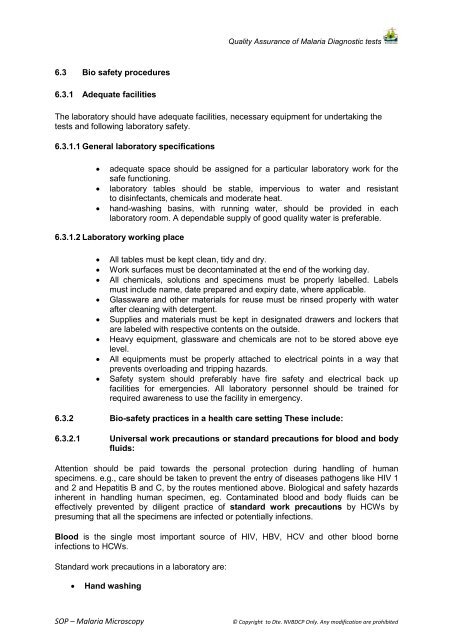SOP â Malaria Microscopy - NVBDCP
SOP â Malaria Microscopy - NVBDCP
SOP â Malaria Microscopy - NVBDCP
Create successful ePaper yourself
Turn your PDF publications into a flip-book with our unique Google optimized e-Paper software.
Quality Assurance of <strong>Malaria</strong> Diagnostic tests6.3 Bio safety procedures6.3.1 Adequate facilitiesThe laboratory should have adequate facilities, necessary equipment for undertaking thetests and following laboratory safety.6.3.1.1 General laboratory specifications• adequate space should be assigned for a particular laboratory work for thesafe functioning.• laboratory tables should be stable, impervious to water and resistantto disinfectants, chemicals and moderate heat.• hand-washing basins, with running water, should be provided in eachlaboratory room. A dependable supply of good quality water is preferable.6.3.1.2 Laboratory working place• All tables must be kept clean, tidy and dry.• Work surfaces must be decontaminated at the end of the working day.• All chemicals, solutions and specimens must be properly labelled. Labelsmust include name, date prepared and expiry date, where applicable.• Glassware and other materials for reuse must be rinsed properly with waterafter cleaning with detergent.• Supplies and materials must be kept in designated drawers and lockers thatare labeled with respective contents on the outside.• Heavy equipment, glassware and chemicals are not to be stored above eyelevel.• All equipments must be properly attached to electrical points in a way thatprevents overloading and tripping hazards.• Safety system should preferably have fire safety and electrical back upfacilities for emergencies. All laboratory personnel should be trained forrequired awareness to use the facility in emergency.6.3.2 Bio-safety practices in a health care setting These include:6.3.2.1 Universal work precautions or standard precautions for blood and bodyfluids:Attention should be paid towards the personal protection during handling of humanspecimens. e.g., care should be taken to prevent the entry of diseases pathogens like HIV 1and 2 and Hepatitis B and C, by the routes mentioned above. Biological and safety hazardsinherent in handling human specimen, eg. Contaminated blood and body fluids can beeffectively prevented by diligent practice of standard work precautions by HCWs bypresuming that all the specimens are infected or potentially infections.Blood is the single most important source of HIV, HBV, HCV and other blood borneinfections to HCWs.Standard work precautions in a laboratory are:• Hand washing<strong>SOP</strong> – <strong>Malaria</strong> <strong>Microscopy</strong>© Copyright to Dte. <strong>NVBDCP</strong> Only. Any modification are prohibited
















